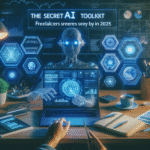In the ever-evolving landscape of technology, artificial intelligence has been both a beacon of innovation and a battleground for security issues. As AI tools become increasingly sophisticated, they also become more attractive to cybercriminals seeking to exploit their capabilities for nefarious purposes. The latest development in this ongoing saga involves the misuse of popular AI models, Mistral and Grok, which have been jailbroken by hackers to concoct potent new strains of malware.
The Dark Side of AI Advancements: A Threat Unveiled
For enthusiasts who revel in AI’s potential to revolutionize industries from healthcare to finance, the news of these tools being repurposed for cybercrime is a stark reminder of the dual-edged nature of technology. While AI models like Mistral and Grok were designed to push the boundaries of computational creativity and efficiency, their jailbroken versions serve a more sinister agenda. By exploiting these tools, hackers can create malware that is not only more sophisticated but also harder to detect, posing significant threats to both individual users and large organizations alike.
Understanding Jailbreaking: The Gateway to Cyber Mischief
To grasp the full impact of this development, it’s crucial to understand what jailbreaking entails. Much like the way tech enthusiasts modify smartphones to bypass manufacturer restrictions, cybercriminals manipulate AI models to unlock hidden capabilities. This process allows them to customize the AI’s functions, tailoring them to craft malware that can infiltrate systems more effectively. Such modifications often involve bypassing security protocols, making these tools more susceptible to misuse.
Implications for Cybersecurity: A New Challenge Emerges
The emergence of malware powered by advanced AI models presents a new frontier for cybersecurity experts. Traditional antivirus software, which relies on pattern recognition and known threat databases, may find itself outmatched by AI-generated malware capable of learning and adapting. This evolution in cyber threats necessitates a shift in defensive strategies, prompting security professionals to incorporate AI-driven solutions themselves. For instance, companies like Palo Alto Networks are increasingly investing in AI-enhanced cybersecurity measures to stay ahead of these rapidly evolving threats.
The Road Ahead: Balancing Innovation and Security
As we navigate this complex landscape, the challenge lies in balancing the benefits of AI innovation with the imperative for robust security measures. While the potential for AI to transform industries is immense, this potential must be tempered with caution and preparedness. For developers and tech companies, this means implementing stringent security protocols and staying vigilant against vulnerabilities that could be exploited by malicious actors. Meanwhile, users must remain informed and cautious, understanding that the tools designed to enhance our lives can also be weaponized.
In conclusion, the misuse of jailbroken AI tools like Mistral and Grok underscores a critical need for vigilance and proactive measures in the AI community. As cybercriminals continue to evolve their tactics, the technology sector must remain agile and innovative in its defenses. By fostering a culture of security awareness and preparedness, we can ensure that AI continues to serve as a force for good, rather than a tool for harm.
Understanding the Threat: Jailbroken AI Tools in the Hands of Cybercriminals
The emergence of jailbroken AI tools like Mistral and Grok has opened a new frontier for cybercriminals. These tools, initially developed to push the boundaries of artificial intelligence research, have been repurposed for malicious activities. By accessing the full capabilities of these AI models, hackers can customize them beyond their original constraints, creating sophisticated malware with alarming efficiency.
When these tools fall into the wrong hands, they can automate the process of generating harmful code or even adapt existing malware to evade detection by traditional security measures. This poses a significant threat as it lowers the barrier to entry for less technically skilled hackers who can now leverage advanced AI capabilities without extensive programming knowledge.
Exploring the Capabilities of Mistral and Grok
Mistral and Grok, renowned for their advanced language processing abilities, are being exploited to craft complex malware that can mimic human-like interactions. This makes detection challenging for conventional security systems that rely on identifying abnormal behavior or patterns. For instance, a jailbroken version of these tools could potentially craft phishing emails that are indistinguishable from genuine communications, tricking even the most cautious recipients.
One hypothetical scenario could involve a cybercriminal using a jailbroken Grok to automate the creation of personalized phishing campaigns. By analyzing publicly available information on social media, the AI could draft emails that appear to come from a trusted contact, increasing the likelihood of the target falling victim to the scam.
The Implications for Cybersecurity: A New Arms Race
The misuse of AI tools like Mistral and Grok for malware development signals a new chapter in the cybersecurity arms race. As these technologies become more accessible, security experts must innovate rapidly to keep pace. Traditional methods of malware detection, such as signature-based approaches, are becoming less effective against AI-generated threats that continuously evolve and adapt.
Strategies for Counteracting AI-Driven Cybercrime
To combat this evolving threat landscape, cybersecurity professionals are turning to AI themselves. By employing machine learning algorithms, security systems can identify anomalies and potential threats more efficiently. For example, AI-driven security platforms can detect unusual patterns in network traffic indicative of an AI-generated attack, allowing for quicker response times.
Moreover, collaborations between AI developers and cybersecurity firms are crucial. By understanding how tools like Mistral and Grok are being manipulated, these alliances can develop more robust defenses. This includes creating AI models specifically designed to counteract malicious activities by predicting potential attack vectors and strengthening system vulnerabilities.
Preventative Measures: Staying Ahead of the Curve
Organizations can adopt several strategies to mitigate risks associated with AI-driven malware. Firstly, investing in advanced threat intelligence systems that leverage AI to anticipate and neutralize threats before they materialize is essential. These systems can analyze vast amounts of data in real-time, providing insights into emerging threats and allowing for proactive defense measures.
Secondly, continuous education and training for employees about the latest cybersecurity threats can prevent human error, which is often the weakest link in organizational security. Simulated phishing attacks and regular updates on the tactics employed by cybercriminals can help maintain a vigilant workforce.
Looking Towards the Future: A Call for Responsible AI Development
As AI technology continues to advance, the responsibility of developers to ensure it is used ethically becomes increasingly critical. Encouraging transparency and accountability in AI development can help prevent misuse. Establishing industry standards and frameworks for ethical AI usage will be vital in preventing tools like Mistral and Grok from being repurposed for cybercrime.
In conclusion, the potential for jailbroken AI tools to facilitate cybercrime underscores the urgent need for comprehensive strategies that blend technology, education, and ethics. By fostering a robust cybersecurity ecosystem that anticipates and neutralizes AI-driven threats, society can harness the benefits of AI while safeguarding against its potential misuses.
For further insights, readers can explore how AI impacts cybersecurity or read about the latest technological advancements in the field.
AI’s Double-Edged Sword: Navigating the Future of Cybersecurity
The emergence of jailbroken AI tools like Mistral and Grok in the hands of cybercriminals highlights a pivotal moment in the cybersecurity realm. It underscores not only the remarkable potential of artificial intelligence but also its susceptibility to misuse. As we delve into this evolving landscape, it’s crucial to recognize that the battle against cybercrime is not just about fortifying defenses but also about outpacing cybercriminals through innovation and vigilance. By looking beyond conventional technology, industries can harness AI’s transformative power responsibly, ensuring that its vast capabilities are used to protect rather than harm.
As we move forward, the focus should be on developing robust AI ethics, implementing stringent security protocols, and fostering a collaborative global effort to counteract these threats. The key to a safer digital future lies in our ability to anticipate and mitigate the risks associated with advanced AI technologies, all while embracing their potential to revolutionize industries.
What are jailbroken AI tools like Mistral and Grok?
Jailbroken AI tools like Mistral and Grok refer to modified versions of AI software that have been altered to bypass security restrictions. These modifications allow cybercriminals to exploit the tools for unauthorized purposes, such as creating sophisticated malware.
How are cybercriminals using these AI tools to build malware?
Cybercriminals leverage the advanced capabilities of jailbroken AI tools to automate and enhance malware creation. These tools can generate complex code more efficiently, evade detection, and adapt to countermeasures, making them powerful assets in cybercrime.
What can be done to prevent the misuse of AI tools?
To prevent misuse, it is essential to enforce strict security measures, develop comprehensive AI ethics guidelines, and promote international cooperation among governments and tech companies. Regular updates and monitoring of AI tools can also help detect and prevent unauthorized modifications.
Are there any legal implications for using jailbroken AI tools?
Yes, using jailbroken AI tools for malicious purposes is illegal and can lead to severe legal consequences. Authorities worldwide are increasingly focusing on crafting legislation and penalties to deter cybercrime involving AI tools.
Discover More in AI and Technology
- Best AI Tools for Product Teams 2025
- Best AI Tools for Content, SEO, and Video 2025
- AI Product Management Tools 2025
- Talkie AI Guide 2025
- How to Use Janitor AI Roleplay Guide
- Perchance AI Chat Story Generator 2025
- Spicy Chat AI Guide 2025
- Zoom AI Companion Guide 2025
- AI Roleplay Guide 2025
- AI Content Generators 2025
- Make AI Character Guide 2025






